Chemistry Research Scholars Program
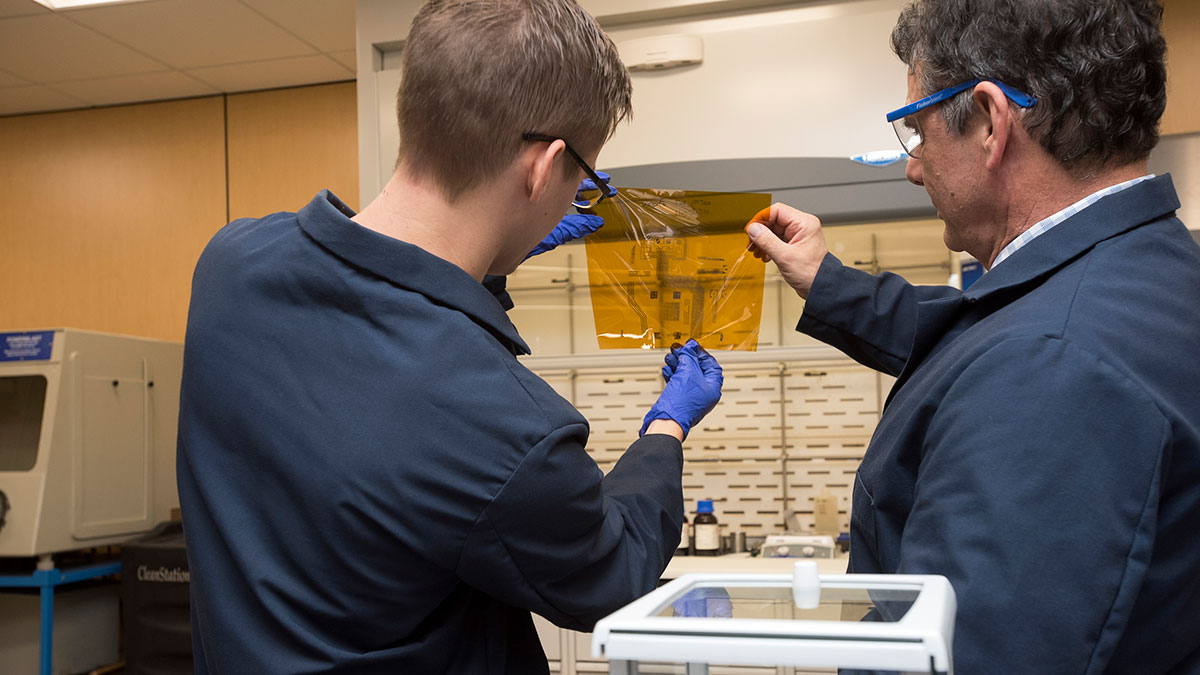
Chemistry Research Scholars
Contact
Suzanne O'Handley
Program Director
sfosch@rit.edu
Jian (Ken) Liu
Program Coordinator
kjlsch@rit.edu
A program designed to recognize and highlight the research achievements of undergraduate students conducting chemically-related research.
The Chemistry Research Scholars Program at RIT increases the visibility of our research students, fosters a culture of undergraduate research, and promotes undergraduate research. It targets students that want to engage in serious undergraduate research for at least three semesters at RIT in the School of Chemistry and Materials Science or chemically-related field. This may include a student who is a major within the school but who chooses to conduct chemically-focused research with a faculty mentor outside of the school. It also includes students not majoring in chemistry or biochemistry but who are conducting research with a faculty mentor within the School of Chemistry and Materials Science.
The program recognizes students who design and execute high-quality research projects under the guidance of their selected faculty mentor. Exceptional work accepted for publication in peer-reviewed journals will be published under the co-authorship of the student and faculty mentor.
2024 Chemistry Research Scholars
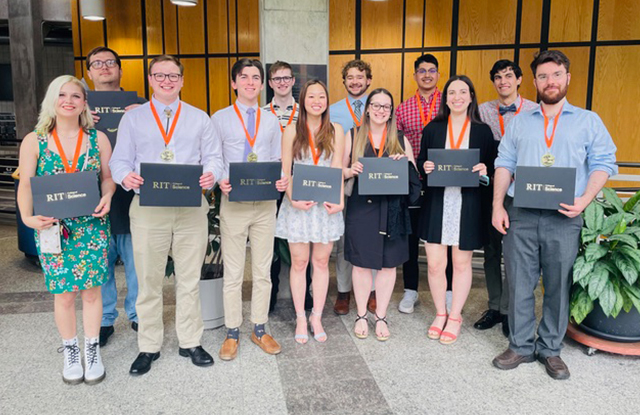
Pictured Left to Right:
Lee Schoneman (Dr. Gleghorn) MS in Bioinformatics, RIT, followed by a PhD in structural biology
L. James Macisco (Dr. Pagano) Graduate School, Chemistry
Matt Henry (Dr. Schmitthenner) A career in the pharmaceutical industry
Aidan Lynch (Dr. O'Handley) University of Connecticut School of Medicine
James Hasselbeck (Dr. Michel) Duquesne University College of Osteopathic Medicine
Peggy Chen (Dr. O'Handley) Lake Erie College of Osteopathic Medicine
Andrew Seyler (Dr. O'Handley) Duquesne University College of Osteopathic Medicine
Martina Videva (Dr. Michel) Medical School
Navraj Singh (Dr. Michel) Medical School
Gabriela Gonzalez (Dr. Michel) Ph.D. in Chemistry, Duke
PJ Nikolai (Dr. Goudreau Collison) A career in industry
Benjamin Rippel (Dr. Takacs) Continue working on the company I created, H2OB LLC.
Not Pictured:
Hunter Heineman (Dr. Takacs, Dr. Goudreau Collison) Volunteer Gap Year
Program Information
Who may enter the Chemistry Research Scholars Program?
Undergraduates who are doing research in the chemical sciences shall be designated in the Chemistry Research Scholars Program including:
- Undergraduates who are doing research with a professor within the School of Chemistry and Materials Science regardless of the student's major, or
- Undergraduates majoring in chemistry or biochemistry, regardless of the school in which the research mentor resides, as long as the research is related to the chemical sciences.
A student must fulfill the requirements below to qualify for admission into the Research Scholars Program:
- Be an undergraduate
- Have done research for at least one semester with the professor who will serve as the student's research mentor within the program
In order to graduate as a research scholar, you must meet all of the criteria listed under progress once you have been admitted to the program.
A one page research abstract written by the student in collaboration with the research mentor and submitted electronically (Research Scholars Program Admission Form and Faculty Mentor Form). The abstract should include the purpose/significance of the research, and a general description of what will be carried out over the course of the project, with the understanding that the direction of research can change as discoveries are made.
- The above mentioned abstract will be submitted to the Chemistry Research Scholars Committee electronically.
- There will be a rolling admission and a student may apply at any time.
A letter of acceptance into the program will be sent to the student.
The student will satisfy the following requirements in order to graduate as a Chemistry Research Scholar:
- Graduate with a GPA of 3.0 or higher.
- Do research with the same research mentor for at least three semesters (1 summer = 2 semesters).
- If the research is conducted within the School of Chemistry and Materials Science, the student will sign up for the "Advanced Chemistry Research" or "Advanced Biochemistry Research" for at least one semester.
- Obtain no grade lower than a B in research while in the program.
- Maintain a research laboratory notebook in accordance with standards set by the research mentor.
- Make at least one off-campus presentation.
- The research student must also meet any other requirements and laboratory rules set by his or her research mentor.
- Final Submission of documentation to complete the Chemistry Research Scholar Program.
At the beginning of the last semester prior to graduation, the faculty research mentor will complete the Faculty Mentor Form attesting that the student has met the requirements of the program and is deserving of the designation Chemistry Research Scholar.
The Chemistry Research Scholars Committee will administer the program to include, acknowledging completed applications, assessing whether submitted documentation meets the specified criteria for the Research Scholars Program, and informing candidates of final decisions.
All students who have successfully completed the Research Scholars Program will be recognized during graduation as "Research Scholars". They will also be recognized at a college-wide Research Scholars awards ceremony in the spring semester.
Faculty Mentors
Physical Chemistry / Biochemistry
The Brini Research Lab uses physics-based computer simulation to connect molecules’ microscopic behavior with macroscopic thermodynamic properties. Biochemistry is a big focus of our research; in particular, we study the interactions between different proteins and between proteins and DNA, how mutations affect these interactions, and if we can identify drugs to modulate the strength of these interactions. We also have a few soft-matter-related projects collaborating with experimental groups to shed light on the mechanism underlying unexpected behavior observed in experiments. We are studying the effect of side-chain length on the glass transition temperature of polyesters and molecular imaging agents’ propensity to aggregate. We are also developing a technique for predicting the crystal structure of organic photovoltaic materials.
Organic Chemistry
The research interests in my group are in the field of organic synthesis. My research is an interplay of activities in the synthesis of biologically relevant molecules and projects in synthetic methodology. Students working in my group will gain research experience in modern synthetic reactions, experimental design, purification techniques, and structure determination.
Organic Chemistry / Chemistry Education
The Goudreau Group is dedicated to chemistry education research in organic chemistry. Improving student performance in organic chemistry and enhancing student confidence relative to organic lab skills were central to the creation of the Reformed Experimental Activities (REActivities) pedagogy. A current research question focuses on student-student engagement during a REActivity lab and how the data is informing the evolution of the guided questions. Their research aims to ensure that students make easier transitions between each level of thinking during an organic lab: macroscopic, sub-microscopic, and symbolic (Johnstone's Triangle). In conjunction with the REActvities project is the Sign Language Incorporation in Chemistry Education (SLICE) project. This project is addressing the challenges of Deaf/Hard of Hearing students in Chemistry through a deliberate effort to develop a lexicon of insightful signs and classifiers that convey chemistry vocabulary to demonstrate challenging concepts. Learn more about the Goudreau Lab at her website.
Physical / Analytical / Materials Chemistry
Our research is centered around fluorescence spectroscopy of 21st-century materials. These materials include conjugated polymers and carbon nanotubes for use in polymer photovoltaics, as well as biological probes. Using fluorescence, we can characterize new materials, study energy transfer, and measure excited state kinetics. Through collaborations with RIT's Nanopower Research Laboratory, we also have access to nanoimaging techniques that allow us to correlate our measured spectroscopic properties with changes in macromolecular structures.
Computational Biochemistry
Dr. Craig’s interest is computational biochemistry, where we use computers to analyze biochemical systems and predict behaviors or functions. The Craig Research Group has three different collaborative projects that all involve developing technology and using the technology to create and explore biochemical information: 1) Jupyter notebooks offer a programming environment that is friendly to non-coders for learning how to use Python. Current targets are developing tools for sorting and analyzing protein sequences, and getting started with cheminformatics. 2) BASIL (Biochemistry Authentic Science Inquiry Lab) is a Course-based Undergraduate Research Experience where students use computational and wet-lab methods to predict and test protein function. Current research targets include creating and testing new course modules focusing on protein structure prediction with AlphaFold and the incorporation of new AI tools for function prediction. 3) JBioFramework is a collection of simulated separations (1D electrophoresis, 2D electrophoresis, ion exchange chromatography, mass spectrometry). Current research targets are educational research on the impact of simulations on student learning and the development of additional protein sets for separations using Python coding.
Analytical Chemistry
The research interests in my group are in the field of atmospheric chemistry. We are interested in understanding how volatile organic species (VOCs) emitted into the atmosphere are oxidized and what is their ultimate fate. Reactions in the atmosphere are simulated in an atmospheric chamber and the oxidation mechanism and kinetics are monitored by sensitive spectroscopic techniques. In addition, we are interested in understanding how the oxidized VOCs form aerosol and what is the molecular composition of these aerosols. To this end, a number of GCMS, LCMS, and spectroscopic techniques are used. This research aids in understanding how the atmosphere works and ultimately aids in improving atmospheric models which are used to simulate and predict the future atmosphere and influence policy decisions.
Physical Organic / Inorganic Chemistry
Dr. Heagy’s interests span a broad range of areas generally centered around physical organic and inorganic chemistry, specifically dual fluorescent probes for biomolecule detection, and dichroic/panchromatic emission (white light) from small molecule dyes. Inorganic chemistry projects have ventured into the synthesis of photocatalysts from hierarchical nanostructures based on earth-abundant, non-toxic semiconductor materials such as iron and zinc oxides. Inspired by artificial photosynthesis, these materials are designed for the mitigation and conversion of greenhouse gases, such as dissolved carbon dioxide or methane to a solar fuel with a high-octane rating such as methanol. For further information on these research opportunities, contact Dr. Heagy.
Physical / Analytical Chemistry
The RIT Magnetic Resonance Laboratory is a research and development laboratory devoted to solving real-world problems with magnetic resonance. The laboratory specializes in the development of magnetic resonance instrumentation and unique applications of magnetic resonance spectroscopy. The laboratory is currently focusing on developing low frequency electron paramagnetic resonance (LFEPR) spectroscopy for studying objects with cultural heritage significance such as renaissance paintings and ceramic objects.
Materials Science / Physical Chemistry / Materials Physics
At the Interface and Structure in Printable Inorganic Electronics (INSPIRON) laboratory, we aim to advance solution-processed semiconductors for terrestrial and space electronics and photovoltaics applications. At its core, our effort is geared toward enabling low-cost and lightweight sustainable and printable electronic devices using high throughput industry-friendly fabrication. We combine interfacial and microstructural diagnostics to understand the inherent complexity in printable thin films, manipulate nucleation and growth, control device interfaces, and use this information to drive innovation at the device level. Next-generation semiconductor inks of interest to us include metal-halide perovskites, metal-oxides, and colloidal nanocrystals. A major recent thrust is to develop an understanding of radiation-matter interactions in these thin film systems for operation in extreme environments, including next-generation space missions, proton cancer therapy, nuclear power, and military applications. In addition to collaborations within SCMS, we also collaborate with the NanoPower Research Laboratories (NPRL) and the AMPrint Center at RIT. Outside of RIT, we collaborate with researchers at the National Renewable Energy Laboratory (NREL), National Aeronautics and Space Administration (NASA), University of Arizona, SUNY Buffalo, University of North Texas, amongst others. At INSIPRON, we aim to inspire the next generation of scientists on the journey to sustainable materials science. Contact us if you are interested, and follow our research and updates on Twitter @Kirmani_Group or on our website.
Materials / Physical / Inorganic Chemistry
Research interests in Dr. Liu’s group lie in design, synthesis, and characterization of inorganic porous nanocatalysts (e.g., metal-organic frameworks (MOFs)) for small molecular gas capture, storage, and catalytic conversions via thermal- and/or photo-catalytic pathways. The target transformations include: (1) direct capture, storage, and conversion of anthropogenic gaseous pollutants (e.g., CO2) to value-added chemicals; and (2) formation, storage, and separation of clean carbon-neutral fuels (e.g., H2 or NH3). We will exploit the controlled synthesis process, the catalyst structures at the atomic or near-atomic scale, the mechanisms of catalytic reactions, and the catalyst structure–function relationships. Key efforts will include in-situ and operando techniques (e.g., DRIFTS, XAS, TEM, and TPD) to explore and understand the gas interactions with the catalysts surface structures and guide the catalyst modification and optimization.
Biochemistry
The Michel Research Group is a protein biochemistry group focused on the role of proteins in disease. We study protein-protein interactions using site-directed mutagenesis, nuclear magnetic resonance (NMR) spectroscopy, and other biophysical techniques, with the goal of understanding how cataracts are formed in the eye lens. We also study protein vaccine candidates from pathogens that cause ear infections and other diseases, as well as protein complexes that are potential novel antibiotic targets. These studies involve recombinant protein expression and purification techniques, as well as enzyme-linked immunosorbent assays, UV-vis spectroscopy, and immunoblotting. Our group also studies small spherical vesicles that are released from bacteria (called bacterial extracellular vesicles or bEVs) that contain proteins, nucleic acids, and lipids similar to their parent bacterium. We aim to better understand how and why these bEVs are released, how antibiotics affect their release, and how we can isolate and detect bEVs in biological samples to use as biomarkers for bacterial sepsis.
Materials Science
Our research investigates the magnetocaloric effect in metallic nanostructures and explores nanoscale magnetic materials for use in advanced refrigeration devices. We also study electronic devices using quantum mechanics. My group makes sensors out of nanoscale magnets. These sensors are in your hard drive; it’s what reads the bits. Magnetic field sensors decipher data stored in magnetic bits on hard disc drives. Our research focuses on the basic properties of magnetic materials on a scale 10,000 times smaller than a human hair.
Organic Chemistry / Biochemistry / Pharmacology
In the exciting field of Chemical Biology, researchers in our lab mix chemistry and biology to explore and investigate the unknowns in the bacterial world. Our mission is to understand how these microorganisms work, with a particular emphasis on elucidating the mechanisms behind their development of resistance to antibiotics. Using medicinal chemistry, organic synthesis, and biochemistry strategies, we create small-molecule chemical probes, which are tools meticulously designed to navigate the intricate pathways and mechanisms that underpin bacterial life. With these probes, we can zoom in and see how bacteria’s inner machinery functions at the molecular level. Our central theme is the battle against antimicrobial resistance, an escalating global threat that demands innovative solutions. By leveraging our small-molecule probes, we investigate the resilient defenses bacteria employ to resist the very drugs designed to combat them. This critical work not only informs the development of new antibiotics, but also offers potential strategies to mitigate the looming crisis of antibiotic resistance.
Polymer Chemistry
Our research group is working on the development of sustainable polymers. These include renewable polymers, i.e. those made from non-fossil fuel-based starting materials, such as plants. We also are interested in synthesizing polymers, which are biodegradable and preferably compostable, such as some polyesters. Our work involves different polymerization methods, organic reactions for the synthesis of novel monomers, e.g. derived from eugenol, and post-polymerization reactions. Our research includes the synthesis of sustainable polymer composites. The obtained polymers are characterized by NMR (Nuclear Magnetic Resonance) DSC (Differential Scanning Calorimetry), GPC (Gel Permeation Chromatography), and other measurements that are more polymer specific.
Biochemistry
Our research entails the discovery and characterization of new enzymes. The enzymes either come from model bacteria such as E. coli or pathogenic bacteria such as M. tuberculosis or Staph. aureus. Enzymes from pathogens have the potential to be novel antibiotic targets. We study members of either the Nudix hydrolase superfamily or the HAD superfamily; in this way, we can understand family relationships as well. Students in the lab do bioinformatics to uncover new enzymes, clone the genes, and express, purify, and characterize the proteins. We also do knock-out mutagenesis to determine the cellular function of some of these enzymes.
Analytical Chemistry / Bioorganic
The goal of the Schmitthenner Research Group is to develop versatile, easy-to-use templates to construct “targeted molecular imaging agents” useful for the early detection of cancer. The templates are chemical scaffolds comprised of peptides with differentially protected side chains. This will enable selective deprotection and binding to different imaging and targeting agents on the same template. The imaging agents are contrast agents for magnetic resonance imaging (MRI), chelating agents for positron emission tomography (PET), and dyes for near-infrared fluorescence (NIRF). The targeting agents are peptides which “seek” cancer cells to selectively image diseased tissues.
Physical / Environmental Chemistry
Surface modification of materials is a key technology for the processing and manufacture of many products which would otherwise be unattainable. By altering the chemical and physical properties of the surface without changing the bulk properties, adhesion to the surface may be greatly improved. Students will work with a number of surface modification techniques in the Plasma Science Laboratory including (1) UV photons; (2) vacuum UV (VUV) photons produced downstream from low-pressure microwave plasmas of rare gases; (3) VUV radiation from inert gas excimers formed in high pressure rotating dc arc experiments; (4) reactive neutral gaseous particles and (5) reactive ions.
Inorganic / Materials Science
The Williams Research Group consists of chemists teaming with engineers to develop new materials and methods for creating next-gen semiconductor electronics that are more efficient, powerful, and durable than current silicon-based semiconductors. Some of the promising materials include 1D-3D gallium nitride (GaN), indium gallium nitride (InGaN), and silicon carbide (SiC). These materials are being doped using a chemical, monolayer deposition, process to add impurities to the semiconductor material, which alters its electrical properties. The Williams Group designs and synthesizes the doping molecular complexes used to create precise and controllable semiconducting doping profiles. In addition to semiconductor electronics, the Williams Research Group is also developing new ceramic glasses with high strength, wide band gap, and chemical resistance properties. These materials are often used in extreme applications where reliable performance and durability are required, such as in high-power electronics, sensors, and optical devices. The Williams Research Group is collaborating with the RIT AMPrint center to explore the use of additive manufacturing to create complex shapes and functions for mechanical, electronic, and optical applications.
Alumni
Class of 2023
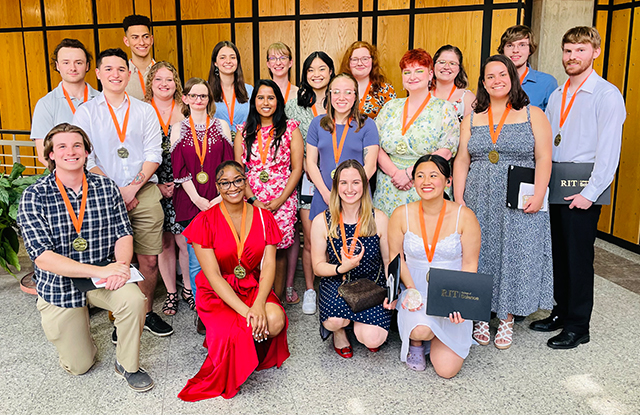
BACK ROW:
Alec Vent (Dr Williams) Medical School at SUNY Upstate Medical College
Adam Robinson (Dr Gleghorn) PhD in translational science
Kathryn Aumick (Dr Williams) PhD in Chemistry at University of Rochester
Natalie Labbe (Dr Michel) PhD in Biological Chemistry at Duke University
Lauren Stewart (Dr Miri) Environmental Engineer at CDM Smith
Jewel Samonte (Dr Miri) PhD in chemistry or materials science
Julia Crandall (Dr Schmitthenner) A career in industry
Molly Roesch (Dr Reed) PhD at University of Chicago or Colorado School of Mines
Andrew O’Brien (Dr Schmitthenner) MS in Chemistry from RIT, PhD in Chemistry
MIDDLE ROW:
Nico Burgado (Dr Michel) Pharmacy School
Ann-Carolin Jahn (Dr Miri) PhD in Organic and Material/Polymer Chemistry at Arizona State
Sreya Antonia Gomes (Dr Pagano) MBA then career as data analyst
Madeline Szwed (Dr Reed) United States Air Force
Mary Elizabeth Kane (Dr Reed) Physical inorganic chemistry research in industry
Elaina Stafford (Dr Schmitthenner) PhD in Medicinal Chemistry
Brian Strohm (Dr Miri) MS in Adolescent Chemistry Education at University @ Buffalo
FRONT ROW:
Jamie Crawford (Dr Michel) Medical School
Yasmeen Cartwright (Dr Michel) Medical School to become a Pediatric Surgeon
Isabelle Pilo (Dr Michel) PhD in Molec Biol, Cell Biol & Biochemistry at Brown University
Anna Kasper (Dr Michel) PhD in Neuroscience or Biomedical Science
Class of 2022
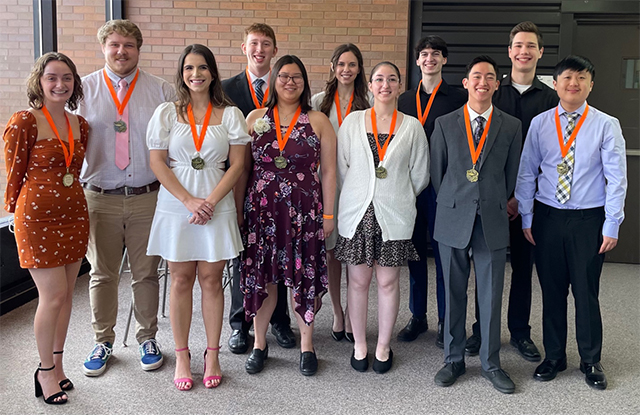
Pictured Left to Right:
Elizabeth Lucas (Dr. O'Handley) Ph.D. in Biochem & Molec Biol, U Rochester
Seth Jones (Dr. Gleghorn) Ph.D. in Biophysics, Strucl & Computational Biology, U Rochester
Luiza Bastos Bianco (Dr. O'Handley) Master in Public Health, Epidemiology, George Washington U
Alex Taylor (Dr. Williams) Industrial Research Scientist
Shao Demyttenaere (Dr. Miri) Bausch and Lomb
Katherine O’Neill-Knasick (Dr. Michel) Medical School
Mariam Dzamukashvili (Dr. Williams) A Career in Forensics
Zach Williams (Dr. Michel) Upstate Medical School
Eugene Ham (Dr. Goudreau Collison) Ph.D. in Chemistry, Career in Art Conservation
Matt Law (Dr. Schmitthenner) PhD in Biochem & Molec Biol, U Rochester
Tommy Wu (Dr. Gleghorn) Medical School
Not Pictured:
Janai Perdue (Dr. Michel) Contract Scientist, Ortho Clinical
Darren Chee (Dr. Goudreau Collison) MBA
Class of 2021

Top Row: Dr. Goudreau, Dr. O’Handley, Dr. Takacs, Dr. Gleghorn, Dr. Mills
2nd Row from Top: Dr. Michel, Dr. Williams, Dr. Heagy, Julia Biehler (Dr. Goudreau) Law School, Jacey Phillips (Dr. Michel) Case Western Postbacc
3rd Row from Top: Dr. Schmitthenner, Danielle Farmer (Dr. Williams) Kodak, Ricardo Carrion (Dr. Schmitthenner) Industry, Kristen Margaret Atkinson (Dr. Takacs) Chemistry Ph.D., Nana Aikins (Dr. O’Handley) Medical School,
Bottom Row: Dr. Coleman, Niaya Jackson (Dr. Michel) Medical School
Not Pictured: Paige Daly (Dr. Goudreau) Medical School, Maha Khokhar (Dr. Michel) Medical School, Emily Mahoney (Dr. Schmitthenner) NorthWestern Chemistry NSF Predoc, and Maddie Tebrugge (Dr. Goudreau) Naval Postgraduate School!
Class of 2020

Top Row: LauraAnne Hirschler (Dr. Goudreau) Medical School, Dr. O’Handley, Dana Murphy Soika (Dr. Schmitthenner) MS Chemistry RIT, Sean Lewis (Dr. Michel) Ph.D. Biomedical Sciences Mayo Clinic
2nd Row from Top: Liam T. Reilly (Dr. Miri) Ph.D. Colorado State, Diksha Biswa (Dr. Goudreau) Doctor of Osteopathic Medical Schools, Peyton Kunselman (Dr. Coleman) MS Chemistry RIT, Dr. Goudreau
3rd Row from Top: Interpreter, Julia Faraone (Dr. Michel) Ph.D. Molecular Biology Ohio State, Morgan Bauer (Dr. Michel) Ph.D. Biomedical Sciences U Michigan, Kaitlyn Clark (Dr. Goudreau) MS Chemistry at RIT
4th Row from Top: Nicolette Kulakowski (Dr. O'Handley) Quality Control Chemist Unither Pharmaceuticals, Kevin DiMagno (Dr. O'Handley) Medical School after a gap year, Spencer Richman (Dr. O'Handley) Research Center for Clinical Systems Biology RGH, Tullio Geraci (Dr. Miri) Ph.D. Arizona State Bottom Row: Wasim Zatar (Dr. Goudreau) MBA/MD, Shreen Sachdev (Dr. Takacs) Packaging Science
Not Pictured: Red Smith-Sweetser (Dr. Miri) Ph.D. U Minnesota
Class of 2019

In Photo:
Kelsea Jones (Dr. Schmitthenner) Ph.D. Chemistry program IOCB & Charles University Prague CZ
Damien Dobson (Dr. Schmitthenner) Ph.D. Chemistry program Purdue
Yang Goh (Dr. Williams) Ph.D. Chemistry program U Southern California
Meghan O’Neil (Dr. Michel) Ph.D. Cell Biology of Disease program U Rochester
Alexander Knowles (Dr. Williams) MS Material Science & Engineering program RIT
Samantha Lauro (Dr. Williams) Chemistry Ph.D. U Texas Austin
Megan Detwiler (Dr. Williams) Research Scientist Samsung Corporation
Cameron Isaac (Dr. Goudreau) School of Dental Medicine U Pittsburgh
Matthew Jackson (Dr. Goudreau) Medical School after a Gap Year
Sara Cobb (Dr. Miri) Packaging Engineer in Healthcare Industry
Nicole Pannullo (Dr. Michel) Ph.D. Cell and Molecular Medicine program Johns Hopkins
Daniel Verrico (Dr. Miri) Ph.D. Macromolecular Science & Engineering program Case Western Reserve
Daniel Knappenberger (Dr. Williams) MS Material Science & Engineering program RIT
Zexuan Maria Jia (Dr. Goudreau) Ph.D. Chemistry program in U Pittsburgh
Missing from Photo:
William Charbonneau (Dr. Miri) Position in Industry
Ciara LaClair (Dr. Michel) Physician Assistant Master after a Gap Year
Minh Le (Dr. O'Handley) Graduate School for a Ph.D. in Biochemistry after a Gap Year
Joe Race (Dr. Williams) Chemistry Ph.D. program Ohio State
Emma Snyder (Dr. Michel) DO program Lake Erie College of Osteopathic Medicine
Class of 2018
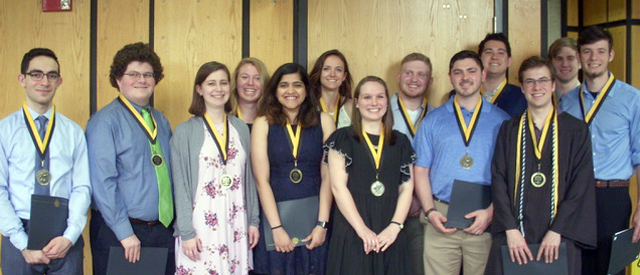
Left to Right: Marc Toro (Dr. Takacs) MS Structural Engineering Program UC Berkeley, Benjamin T. Catalano (Dr. Rocha) Ph.D. Chem Program U Penn, Sarah Stanton (Dr. Michel) Nursing Program U Rochester, Kara Farquharson (Dr. Michel) MS Chem Program RIT, Shivani Phadke (Dr. Michel) MS Biotech Program, Northeastern, Kaitlyn Houghtling (Dr. Goudreau) Ph.D. Chem Program U Rochester, Rebecca Bogart (Dr. Cody) Ph.D. Chem Program U Vermont, Tyler Zimmermann (Dr. Goudreau) QC Chemist Tangram Co, Sam Lucisano (Dr. Smith) Xerox, Robert Ichiyama (Dr. Williams) Ph.D. Chem Program Rhode Island, Thomas Hynes (Dr. O’Handley) Gap Year then Medical School, Scott Humski (Dr. Willams) Klockner Pentaplast, Ryan Le Tourneau (Dr. Schmitthenner) Ph.D. Chem Program UC Irvine
Not Pictured: Daniel Honeycutt (Dr. Miri) Lab Tech Axalta Coating Systems, Tobias Hull (Dr. Reed) Ph.D. Program U Colorado, Shin Lutondo (Dr. Takacs) Product Developer Unilever
Class of 2017
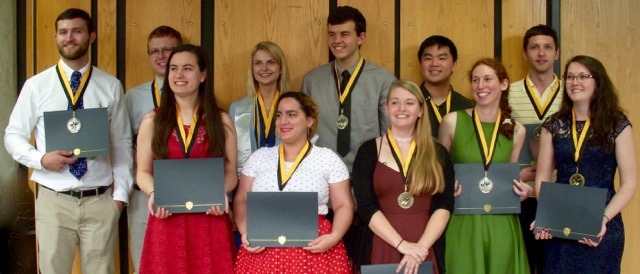
Back Left: William Marmor (Dr. Tina Goudreau) Stoneybrook Medical School, Mike Cattalani (Dr. Tina Goudreau) Gap Year, Julianne Caponigro (Dr. Tina Goudreau) Gap Year, Andrew Streit (Dr. Tina Goudreau) Ph.D. Program Yale University, Jacky Lim (Dr. Hans Schmitthenner) Ph.D. Program UConn, Andrew Dicola (Dr. Suzanne O’Handley) MS Program RIT
Front Left: Brooke D’arcy (Dr. Lea Michel) Ph.D. Program Duke University, Ana Cartaya (Dr. Tina Goudreau) Ph.D. Program UNC-Chapel Hill, Taylor Wolf (Dr. Scott Williams) Ph.D. Program St. Jude Research Hospital, Melissa Koch (Dr. Scott Williams) Ph.D. Program U. of Rochester, Ashley Murphy-Shaw (Dr. Jeremy Cody) Medical School Campbell University College of Osteopathic Medicine
Not Pictured: Kevin O’Donovan (Dr. Suzanne O’Handley) Research Technologist at St. Jude Children's Research Hospital, Cassandra Martin (Dr. Suzanne O’Handley) Gap Year
Class of 2016
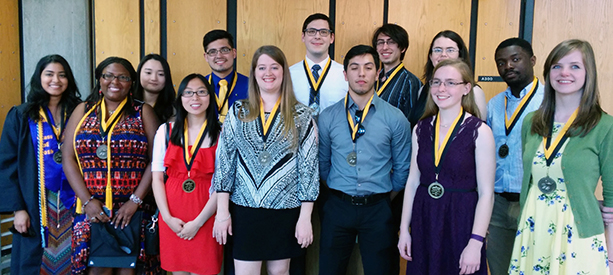
From left to right back row: Lucinda Dass (Dr. Suzanne O'Handley) Medical Internship in Toledo Spain and Medical School, Xinyun Li (Dr. Alla Bailey & Dr. Gerald Takacs) Returning to China and a potential graduate program, Tyler Hess (Dr. Scott Williams) MS program, Sustainability Systems, RIT, Paul Fanara (Dr. Jeremy Cody) Ph.D. program, Chemistry, University of Buffalo, Ian Bencomo (Dr. Jeremy Cody) Ph.D. program, Organic Chemistry, University of Chicago, Hannah Simpson (Dr. Christina Goudreau Collison) Ph.D. Program, Chemistry, Purdue, Tumi Faniyan (Dr. Christina Goudreau Collison)
From left to right front row: Jasmine Edwards (Dr. Suzanne O’Handley) Ph.D. program, Biomedical Sciences, University of Miami, Amy Huang (Dr. Nathan Eddingsaas) Ph.D. program, Biology, Columbia University, Lauren Heese (Dr. Hans Schmitthenner) Ph.D. program, Biomedical Sciences, Angel Payan (Dr. Lea Michel & Dr. George Thurston) PREP Scholar, University of Pennsylvania, Elizabeth May (Dr. Scott Williams) Ph.D. program, Biological Sciences, Harvard University, and Sarah Kearns (Dr. Moumita Das) Ph.D. program, Chemical Biology, University of Michigan
Not Pictured: Nnamdi Akporji (Dr. Hans Schmitthenner) Ph.D. program, Organic Chemistry, UC Santa Barbara, Joseph Marsico (Dr. Massoud J Miri) Laboratory Technician, Kaylee Matthews (Dr. Lea Michel) Ph.D. program, Molecular, Cell, and Biochemistry, Brown University, and Michael Regan (Dr. Hans Schmitthenner) Ph.D. program, Polymer and Organic Chemistry, Clarkson
Class of 2015
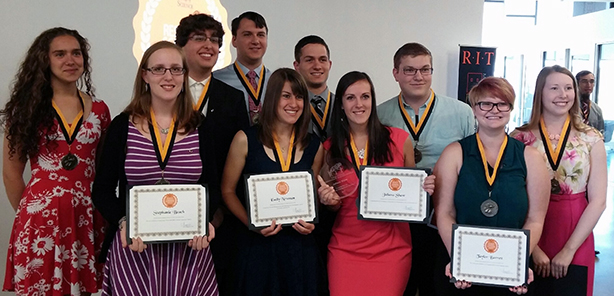
From Left to Right: (Back row) Brandon Cona (Dr. Chris Collison) MS Program Biological Sciences at Tokyo University; Russell Burkhardt (Dr. Jeremy Cody) Ph.D. program Cornell University; Jordan Armeli (Dr. Suzanne O’Handley) PharmD program at Albany; David Barnard (Dr. Lea Michel) Ph.D. program U. of Rochester; Lauren Switala (Dr. Joe Hornak) MS program Cleveland State; Stephanie Beach (Dr. Hans Schmitthenner), Ph.D. Program Boston University; Emily Newman (Dr. Lea Michel) MD at Cincinnati School of Medicine; Julianna Shaw (Dr. Lea Michel) Ph.D. program Yale University; Taylor Barrett (Dr. Hans Schmitthenner) Ph.D. Program UPenn; Chelsea Weidman (Dr. Hans Schmitthenner) Ph.D. Program Boston College.
Class of 2014

From Left to Right: Laura Parisi (Dr. Matt Miri) Ph.D. program at University at Buffalo, Austin Kelly (Dr. Tina Goudreau) Ph.D. Program UC San Diego, Tessa DiDonato (Dr. Suzanne O'Handley) Ph.D. Program Boston University, John Bettinger (Dr.Lea Michel) Ph.D. program University of Toronto, Kimbria Blake (Dr. Suzanne O'Handley) Ph.D. Program Harvard University, Kyle Oliver (Dr. Jeremy Cody) Ph.D. Program University of Maryland.
Not Pictured: Sofiya Hlynchuk (Dr. Jeremy Cody) Ph.D. program University of Michigan, Katherine Valentine (Dr. Tina Goudreau) Ph.D. Program Virginia Tech.
Class of 2013
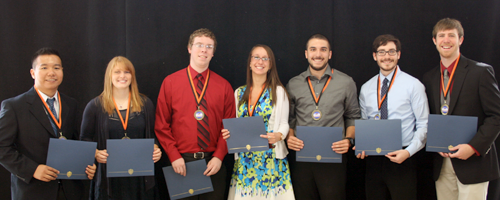
From Left to Right: Tri Nguyen (Dr. Michael Coleman), Carly Augustyn (Dr.Jerry Takacs) Research Assistant iCardiac Technologies, Mike Madaio (Dr. Suzanne O'Handley) Infectious Disease Lab Technician, Joy Snyder (Dr.Lea Michel) PharmD program at SUNY Buffalo, Christian Larrabee (Dr. Jeremy Cody), Anthony Carestia (Dr. Tina Goudreau Collison) Ph.D. Program UNC Chapel Hill, Ken Gerien (Dr. Suzanne O'Handley) Ph.D. Program Ohio State, Rachel Schmidt
Not Pictured: Dr. Lea Vacca Michel / Ph.D. in Physiology at Cornell University
Class of 2012
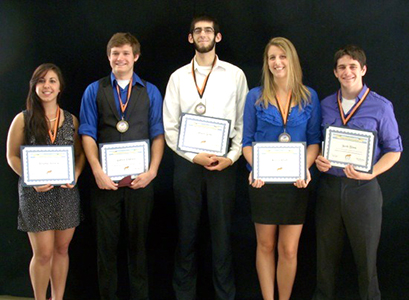
From Left to Right: Bre Kalmeta (Dr. Lea Michel) Ph.D. Program at Duke University, Andrew Pinkham (Dr. Thomas Kim) Ph.D. Program at Ohio State University, Sam Ziebel (Dr. Jeremy Cody) Ph.D. program at SUNY at Buffalo, Lauren Resch (Dr. Jeremy Cody) Ph.D. program at University of Maryland Baltimore County, Jake Tatum (Dr. Jeremy Cody) Applying to Medical Schools
Class of 2011
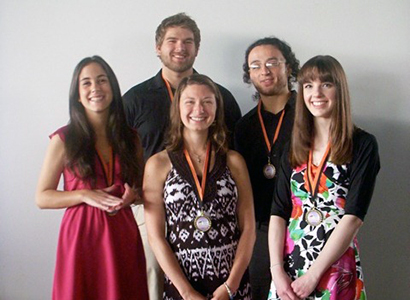
Back Row From Left to Right: Joel Walker (Dr. Thomas Smith) Ph.D. Program in Chemistry at the University of Vermont, Sebastian Ramirez (Dr. Suzanne O’Handley) Ph.D. Program in Chemical Biology at the Johns Hopkins University
Front Row From Left to Right: Alejandra Rizo-Patron (Dr. Suzzane O´Handley) Montana Ingredients Manufacturer in Peru, Jennifer Milillo (Dr. Lea Michel) Medical School at SUNY Buffalo, Rebecca Smith (Dr. Joseph Hornak) Ph.D. Program in Chemistry at the University of Rochester
Not Pictured: Thomas Spencer Bailey (Dr. Jeremy Cody) Ph.D. Program in Chemistry at the University of Oregon
Class of 2010
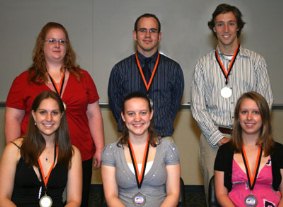
Back Row From Left to Right: Jennifer Swartzenberg (Dr. Tina Collison) Masters Program at RIT, D.J.Tusch* (Dr. Jeremy Cody) Ph.D. program at U. of Rochester, Joshua Thomson* (Dr. Suzanne O'Handley) Teach for America.
Front Row From Left to Right: Laura Filkins (Dr. Laura Tubbs) Ph.D. program at Dartmouth, Amber Monfette (Dr. Matt Miri) Research Assistant in Nanopower Research Lab at RIT, Jessica Alexander* (Dr. Chris Collison) Ph.D. program at MIT.
* Designates Distinguished Research Scholar awardee
Class of 2009
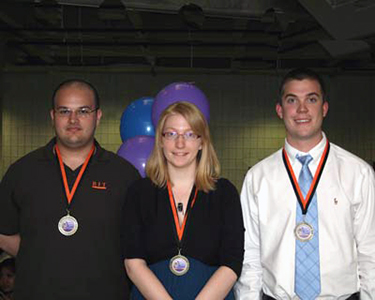
From Left to Right: Matthew Fullana (Dr. Matt Miri) Ph.D. program at Case Western University, Lindsay Cade (Dr. Scott WIlliams) Research Lab at Massachusetts General Hospital, Timothy Liwosz* (Dr. Tina Collison) Ph.D. program at University of Buffalo.
* Designates Distinguished Research Scholar awardee
Class of 2008
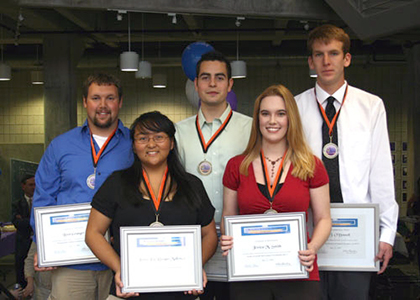
From Left to Right: Brett Granger* (Dr. Tina Collison) Ph.D. Program, University of Texas, Austin, Jamie Lou Mallonga (Dr. Laura Tubbs) Proteomics Research, Pall Corporation, Long Island, NY, Julian Ramos* (Dr. Suzanne O'Handley) Ph.D. Program, University of Washington, Jessica Smith* (Dr. Tina Collison) Ph.D. Program, University of Rochester, Marc O'Donnell* (Dr. Chris Collison) MD Program, NYU
* Designates Distinguished Research Scholar awardee
Class of 2007
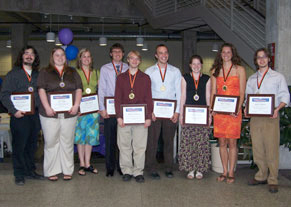
From Left to Right: Steven Pellizzeri* (Dr. Chris Collison) Ph.D. program, North Carolina State, Julia Kohn (Dr. Laura Tubbs) University of Rochester Teaching Certification, Sarah Denial* (Dr. Suzanne O'Handley) Ph.D. program, Cornell University, Brad Loesch (Dr. Marvin Illingsworth) Robert Pasquarelli* (Dr. Marvin Illingsworth) NREL, Greg Horracks (Dr. Marvin Illingsworth) Rachel Pleuthner (Dr. Paul Craig) Marie Krysak* (Dr. Jerry Takacs) Ph.D. program, Cornell University, Ryan Walvoord* (Dr. Tina Collison) Ph.D. program, University of Pennsylvania
* Designates Distinguished Research Scholar awardee
Class of 2006
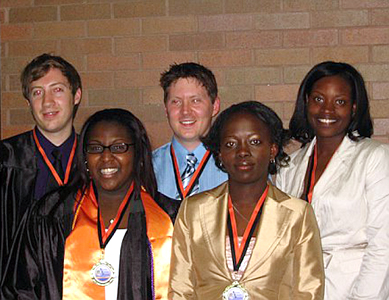
Back Left: Mark Zimmerman (Dr. Paul Craig) MBA program, RIT, Joseph Peterson (Dr. Marvin Illingsworth) Polymer Ph.D. program, UMass Amherst, April Colleton (Dr. Chris Collison) Ph.D. program, University of North Carolina Chapel Hill
Front Left: Nakesha Smith (Dr. Laura Tubbs) Ph.D. program, SUNY Albany, Olukorede Agusto (Dr. Tina Collison) Ph.D. program, University of Pittsburgh




















